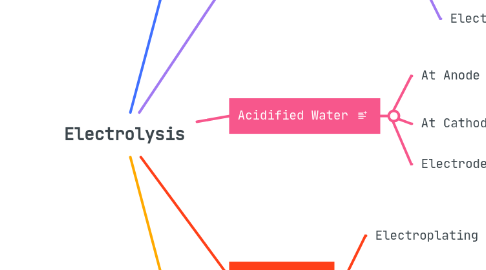
1. Electrolytic cell
1.1. Electrolyte
1.1.1. Types of Electrolyte
1.1.1.1. Strong Electrolyte
1.1.1.2. Weak Electrolyte
1.1.1.3. Non Electrolyte
1.2. Electrodes
1.2.1. Types of Electrodes (based on reactivity)
1.2.1.1. Active Electrode
1.2.1.2. Inert Electrode
1.2.2. Types of Electrodes (based on connection to Cell / battery)
1.2.2.1. Anode (Oxidising electrode) - Positive electrode
1.2.2.2. Cathode (Reducing electrode) - Negative electrode
2. Molten Lead Bromide
2.1. At Cathode
2.1.1. Lead (Pb2+)
2.1.1.1. Silvery grey metal deposits
2.2. At Anode
2.2.1. Bromine vapours (Br-)
2.2.1.1. Brown vapours evolves
2.3. Electrode material
2.3.1. Graphite
3. Acidified Water
3.1. At Anode
3.1.1. Oxygen (O2)
3.1.1.1. Rekindles a glowing splinter
3.2. At Cathode
3.2.1. Hydrogen (H2)
3.2.1.1. Burns with a pop sound
3.3. Electrode material
3.3.1. Platinum / Graphite
4. Applications
4.1. Electroplating
4.1.1. Silver plating
4.1.2. Nickel plating
4.2. Electrorefining
4.2.1. Refining of Impure Copper
4.3. Electrometallurgy
5. Aqueous Copper Sulphate
5.1. by using Active electrode (Copper)
5.1.1. At Anode
5.1.1.1. Release of Copper ions
5.1.1.1.1. Anode diminishes in size / mass
5.1.2. At Cathode
5.1.2.1. Copper ions reduce and deposits over cathode
5.1.2.1.1. Cathode size / mass increases
5.1.3. Electrolyte
5.1.3.1. Remains blue as Copper ions of solutions are getting replaced by Copper ions coming from Anode
5.2. by using Inert electrode Graphite
5.2.1. At Anode
5.2.1.1. Release of Oxygen(O2)
5.2.1.1.1. Rekindles a glowing splinter
5.2.2. At Cathode
5.2.2.1. Copper ions reduce and deposits over cathode
5.2.2.1.1. Brownish pink metal Copper deposits
5.2.3. Electrolyte
5.2.3.1. Blue colour of Copper sulphate fades as there are no Copper ions are left in the solution
